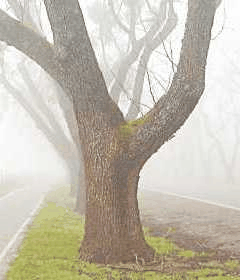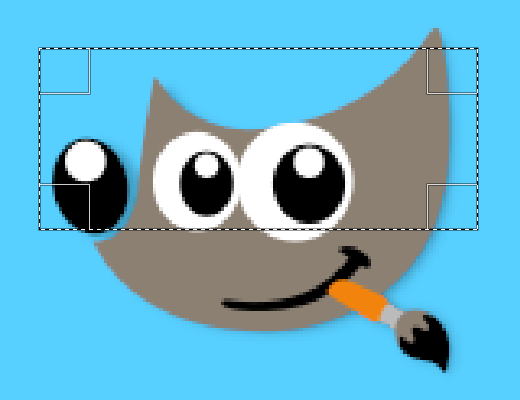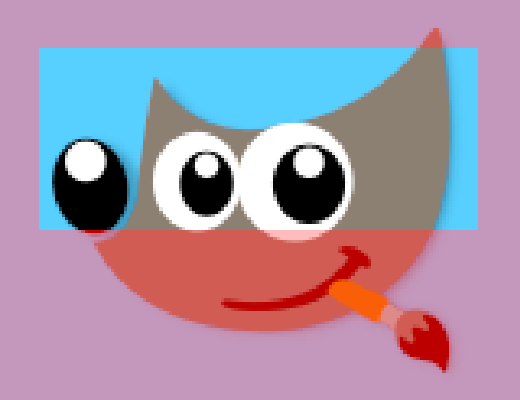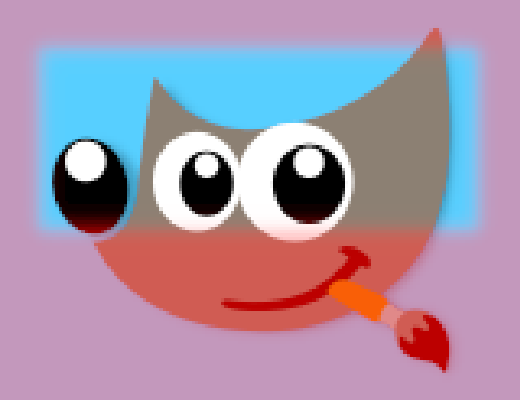Índice
Eventualmente pode acontecer de você estar trabalhando numa imagem, e querer que apenas uma parte da imagem seja afetada. No GIMP, você pode fazer isso acontecer selecionando a região desejada. Cada imagem tem uma seleção associada a ela. A maioria, mas não todas, as operações do GIMP funcionam apenas em partes selecionadas da imagem.
Há muitas, muitas situações em que a criação de apenas uma seleção certa é a chave para obter o resultado desejado, e muitas vezes isso não é fácil fazer. Por exemplo, na imagem acima, suponha que eu queira cortar a árvore separando-a do fundo, e colando-a em uma imagem diferente. Para fazer isso, eu preciso criar uma seleção que contenha a árvore e mais nada. É difícil porque a árvore tem uma forma complexa, e em vários pontos é difícil distinguir os objetos por trás dela.
Agora aqui está um ponto muito importante, e é crucial entender isso. Normalmente, quando você cria uma seleção, você a vê como uma linha tracejada contendo uma parte da imagem. Uma ideia comum, mas não muito correta, mas que serve como ideia inicial, é que a seleção é uma espécie de recipiente, com as partes selecionadas da imagem dentro, e as partes não selecionadas fora. Embora este conceito de seleção seja bom para muitos propósitos, não é inteiramente correto.
Na verdade, a seleção é implementada como um canal. Em termos da sua estrutura interna, ela é idêntica aos canais vermelho, verde, azul, e alfa de uma imagem. Assim, a seleção tem um valor definido em cada pixel da imagem, variando entre 0 (não selecionado) e 255 (totalmente selecionado). A vantagem desta abordagem é que ela permite que alguns pixels sejam selecionados parcialmente, dando-lhes valores intermediários entre 0 e 255. Como você poderá ver, há muitas situações onde é desejável ter transições suaves entre as regiões selecionadas e não selecionadas.
O que, então, é a linha tracejada que aparece quando você cria uma seleção?
A linha tracejada é uma linha de contorno, dividindo as áreas que são selecionadas com mais da metade do valor (128) de áreas que são menos selecionadas.
While looking at the dashed line that represents the selection, always remember that the line only tells part of the story. If you want to see the selection in full detail, the easiest way is to click the Quick Mask button in the lower left corner of the image window. This causes the selection to be shown as a translucent overlay atop the image. Selected areas are unaffected; unselected areas are reddened. The more completely selected an area is, the less red it appears.
Many operations work differently in Quick Mask mode, as mentioned in the Quick Mask overview. Use the Quick Mask button in the lower left corner of the image window to toggle Quick Mask mode on and off.
With the default settings, the basic selection tools, such as the Rectangle Select tool, create sharp selections. Pixels inside the dashed line are fully selected, and pixels outside completely unselected. You can verify this by toggling Quick Mask: you see a clear rectangle with sharp edges, surrounded by uniform red. Use the “Feather edges” checkbox in the Tool Options to toggle between graduated selections and sharp selections. The feather radius, which you can adjust, determines the distance over which the transition occurs.
If you are following along, try this with the Rectangle Select tool, and then toggle Quick Mask. You will see that the clear rectangle has a fuzzy edge.
Enevoar é muito útil quando você precisa cortar e colar, pois o objeto colado se combina suavemente com o entorno.
It is possible to feather a selection at any time, even if it was originally created as a sharp selection. Use → from the main menu to open the Feather Selection dialog. Set the feather radius and click . Use → to do the opposite—sharpen a graduated selection into an all-or-nothing selection.
![[Nota]](images/note.png)
|
Nota |
|---|---|
|
Explicando para os leitores mais técnicos: enevoar aplica uma desfocagem gaussiana no canal da seleção, com o nível de desfocagem igual ao raio selecionado. Você pode obter o mesmo efeito usando o filtro de desfocagem gaussiana com a Máscara Rápida ativa. |
Você pode escolher a opacidade da camada, mas não pode fazer o mesmo para uma seleção diretamente. Isso é muito útil para tornar a imagem de um vidro transparente ou translúcida. Use os métodos a seguir para alterar a opacidade da camada:
-
Para seleções simples, use a ferramenta “Borracha” com a opacidade desejada.
-
For complex selections: use → to create a floating selection. This creates a new layer with the selection called “Floating Selection” (Seção 4.5, “Flutuar”). Set the opacity slider in the Layers dialog to the desired opacity. Then anchor the selection: outside the selection, the mouse pointer includes an anchor. When you click while the mouse pointer includes the anchor, the floating selection disappears from the Layers dialog and the selection is at the right place and partially transparent (anchoring works this way only if a selection tool is activated: you can also use the Anchor Layer command in the context menu by right clicking on the selected layer in the Layers dialog).
And, if you use this function frequently: Ctrl-C to copy the selection, Ctrl-V to paste the clipboard as a floating selection, and → to turn the selection into a new layer. You can adjust the opacity before, or after creating the new layer.
-
Another way: use → → to add a layer mask to the layer with the selection, initializing it with the selection. Then use a brush with the desired opacity to paint the selection with black, i.e. paint it with transparency. Then → → . See Seção 2.1.4, “Máscaras de camada”.
-
Para o fundo sólido de uma imagem se tornar transparente, adicione um canal alfa, e use a ferramenta de seleção contígua (varinha mágica) para selecionar o fundo. Então, use a ferramenta “Seletor de cores” para selecionar a cor de fundo, o que fará com que ela seja a cor de frente na caixa de ferramentas. Use então a ferramenta de “Preenchimento” (baldinho) com a cor selecionada. Use a ferramenta de Preenchimento no modo “Apagar cor”, o que fará com que os pixels com a cor selecionada sejam apagados; outros pixels serão parcialmente apagados e a cor será alterada.
Outro método simples está em → , o que deixará a seleção completamente transparente, se a camada tiver um canal alfa.







